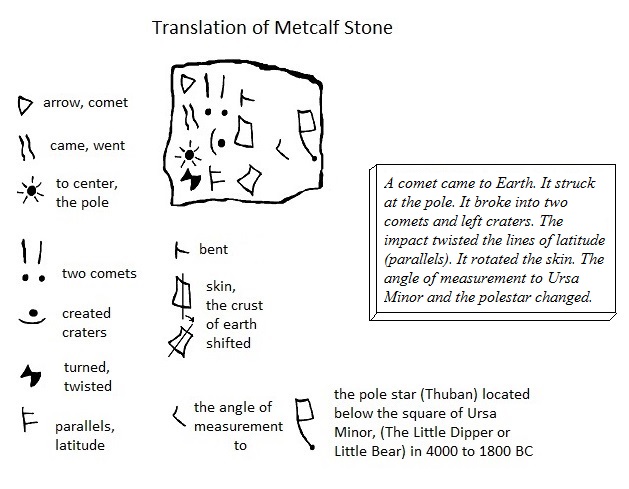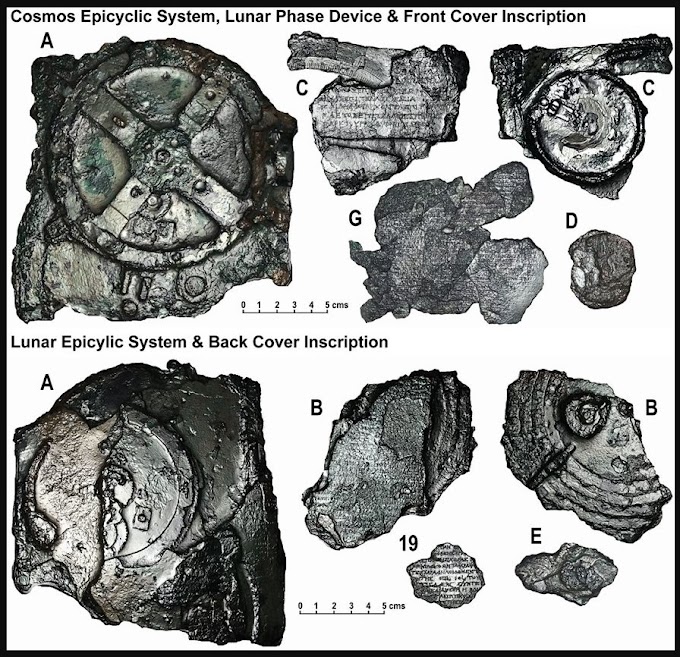Αφού ερεύνησα την επιγραφή, ήταν προφανές για μένα πως η γραφή ηταν ίδια με αυτή της Μινωικής Γραμμικής Α και Μυκηναικής Γραμμικής Β. Συνεπώς υπήρχε μια επαφή μεταξύ Αμερικής και Αιγαίου στην Εποχη του Χαλκού κοντά στις Νότιες, Δυτικές και Βόρειες ακτές στον Κόλπο του Μεξικού. Αυτό δεν μπορεί να ειναι τυχαίο! Η Αρχαίες επιγραφές των πολιτισμών του Αιγαίου σε τρια διαφορετικά σημεία του Κόλπου αντανακλά τα υπερατλαντικά ταξίδια μεταξύ της Μεσογείου και του Νέου Κόσμου γύρω στα μέσα της 2ης χιλιετίας π.Χ.-Cyrus Gordon (Αμερικάνος Αρχαιολόγος και Γλωσσολόγος με ειδικότητα στις γλώσσες της Εγγύς Ανατολής)
The Metcalf Stone Gives Up Its Secret
Copyright © 2013 by B.L. Freeborn, updated Sept. 2022

Two views of the Metcalf Stone. (The peck mark on the center left bottom symbol does not appear in the right photo.)
An exciting new series of posts begins! New translations of ancient North American Stones …..
The Metcalf Stone is a unique and important discovery. It was found by Manfred Metcalf in 1967 at Fort Benning outside Columbus, Georgia. This eleven by eleven inch stone was part of a chimney foundation from a house built prior to 1889 eliminating the idea of a recent forgery. Several individuals believe the symbols are Linear A. But some symbols do not fit the script so it is, as of yet, unread. (See sketch below.)
There are twelve symbols on the stone composed of sixteen components. This is significant. Twelve indicates the number of months in the year and the number of signs in the zodiac. Sixteen reminds us that the Earth travels 1600,000 miles in any given day. Counting punch marks from far right to left moving upwards we find 1,1, and 3 which creates the number 113. This is 2 x 56.5. Or count them as 2, 3 or 3, 2. This 23 – 32 was significant at Newark and on the Aberlemno Stone from Scotland. Indeed, counting the placement of the symbols, there are four in the first column and three in the second giving us 43 which is half 86. The diameter of the sun is 864,000 miles. The remaining columns must be read left to right to give 1,1,3 or 113. This is 2 x 56.5 which is a reiteration of the 56.5 above. This number was seen in the Newark Decalogue Stone. Continuing along this line from left to right is 1 and 1 or 11. Returning, moving right to left, the remaining columns then count 3, 3, 4 symbols. This creates 33.4 which is significant as we saw in the Newark Earthworks and the Norrie’s Law medallion also from Scotland. This method of item counts with punches is identical to what was found on the 5,000 year old Knowth and Newgrange Kerb Stones from Ireland giving one a good idea of when and by whom these stone documents were inscribed.
Three of the symbols can be easily identified as mathematical symbols. Note the symbols for parallel lines, a bent angle and an angle. The bottom left symbol is very similar to the letter quo in Phoenician during the 7th to 1st century B.C. Prior to that in 1000 B.C. it was depicted as a circle with a stick out of its center to the bottom which is more stylized in a modern Q. Today, in engineering discussions, a ball on top of a stick is used to symbolize a structure and how it moves. This double triangle symbol was a Z in South Semitic scripts in 1000 B.C. The Phoenician symbol for Z in that time period looked more like a capital I. We can understand this symbol by seeing it as a rectangle that has twisted like a bag-twisty.
The left top symbol is not a triangle but a dagger or sword which is easily identified in other art from the pre-Christ era. The two symbols in the third column are animal skins. Archaeologists have wondered why copper ingots were cast in this shape. Here then we have an answer. Copper is cast in the shape of a skin in remembrance of the comet, composed of copper, which moved the skin of the Earth.
The most interesting symbol on the piece is on the right hand side made of the square and the downward stroke ending in a punch mark. Comparison with the constellation Ursa Minor quickly proves it is not exactly this star cluster. Comparison of the layout with a star map shows that the pole star from 4000 BC to 1800 BC, Thuban, is being indicated which gives us a reference for the time period to which the stone relates, was first written, or it is just a mirror image of Ursa Minor and so a simple reference to the pole star.
The translation is thus read from top left downwards in columns towards the right except for the bottom row which reads left to right for two symbols. So then, there is enough information to translate this stone as shown in the last diagram.
A comet came to Earth.
It struck at the pole.
It broke into two comets
and left craters.
The impact twisted the lines
of latitude (parallels).
It rotated the skin.
The angle of measurement
to Ursa Minor and
the pole star changed.
In the coming months the Ohio Tablets, Gridley Stone, Hopewell Shaman Statue, and Ohio Adena Pipe will be studied. They are fabulous ancient art each with an extraordinary message to tell.
The Adena Tablets – The Grave Creek Stone
© 2015 B. L. Freeborn, updated May 2025
The Grave Creek Stone was found in the Grave Creek Mound close to the Ohio River in West Virginia. Translations have been done, one in jest, but none seem satisfying. An excellent place to review the controversy surrounding the stone is at J. Huston McCulloch’s site linked here. The original Smithsonian photo of the stone and Schoolcraft’s art are from his site and his efforts are greatly appreciated.
There are several ideas that have been consistently overlooked in translating the stone. The lines on the stone are always assumed to be guides for writing such as ruled school paper. Since most persons attempting to translate this stone read and write English which is presented horizontally it has never occurred to anyone they are not guide lines and represent something else. Perhaps they represent lines of longitude and the stone should be rotated to be read in a vertical manner.
The Grave Creek Mound is shown here and a similar mound below Dayton is also shown. It is found in Miamisburg.
The decipherment of the stone resolves itself quickly as seen here when it is compared to Kerbstone 86 from the ancient ruins in Knowth, Ireland (3000 BC) and when compared to the Metcalf stone from Georgia. The Metcalf Stone began this series. The kerbstone was studied in a prior posting as well. The comparison shows the symbols from the kerbstone are located in the middle line if the stone is rotated and read in a vertical manner. The top is confirmed by comparison to the Metcalf stone as shown in the image. The two symbols at the bottom of the columns are out of alignment intentionally. One indicates 3 and the other 2 for 32 or the square of 5.65 is where the misalignment lies.
 Although it is believed these glyphs are letters, it is more likely they are simple small pictures that tell the same story as the Metcalf and as depicted on the Mystery Stone from New Hampshire. It is the same story depicted on the other Adena Tablets. Several of the glyphs appear to be forerunners to Phoenician letters including the symbols interpreted here as numbers at the bottom of the middle row.
Although it is believed these glyphs are letters, it is more likely they are simple small pictures that tell the same story as the Metcalf and as depicted on the Mystery Stone from New Hampshire. It is the same story depicted on the other Adena Tablets. Several of the glyphs appear to be forerunners to Phoenician letters including the symbols interpreted here as numbers at the bottom of the middle row.
 It is as if this is all to commemorate a separation of the North Pole from Magnetic North.
It is as if this is all to commemorate a separation of the North Pole from Magnetic North.
The stone is then translated as shown and reads:
The two eyes lie at 79 degrees and 56.5 degrees in the lake.
The object struck the pole at the top and pushed it down.
The pole was stricken by two arrows and craters.
It was split and shaken.
The one place of the mountain became a great valley.
It measured the heavens.
The numbers’ order rotated.
Arisen is a pole and it is the foot for measurement of angles.
Measure also from the stricken pole place.
………………





























